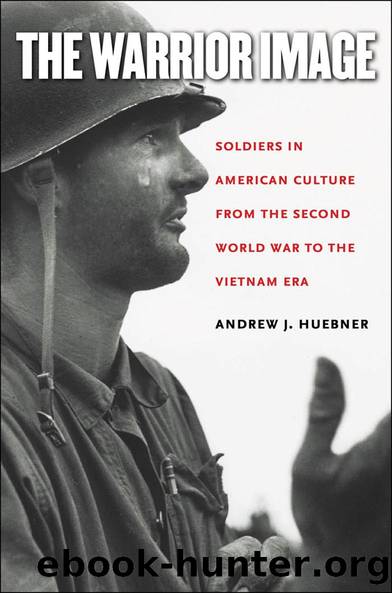The Warrior Image by Andrew J. Huebner

Author:Andrew J. Huebner [Huebner, Andrew J.]
Language: eng
Format: epub
Tags: History, United States, 20th Century, Military, Social Science, Popular Culture
ISBN: 9780807868218
Google: fx1Nx_i3iw0C
Publisher: Univ of North Carolina Press
Published: 2011-12-01T15:58:34+00:00
FIGURE 15.âInvasionDMZRuns into the Marines,â Life, October 28, 1966. In 1966 popular magazines began featuring such helpless, bandaged soldiers on their covers or in articles. Courtesy of Time & Life Pictures/Getty Images.
Such images were not necessarily âantiwarâ; journalists surely understood that wounds and death were a part of any conflict. And most correspondents and editors in 1966 still supported the American intervention in Vietnam. But these images, like ones from Korea, reminded viewers of warâs costs. In this way reporters valorized the suffering of the individual GI, made him seem pitiable, but without questioning his manliness or toughness, and without explicitly condemning the wider war effort in Southeast Asia. As Susan Moeller has written, combat photographers in Vietnam âtook portraits of the troops to champion the fortitude of the individual soldiers in their sad triumph over the hardship of warfare.â78 In these portraits war was a messy, tragic business. As the conflict later stalemated, such exposure of suffering overtook support for the war in stories from Vietnam.
Deliberate or inadvertent abuse of civilians, Vietcong prisoners, and enemy suspects continued to command significant attention. Sometimes such damage seemed justified. Dan Rather reported from Vietnam in January 1966: âIn this village along the Saigon riverbanks, residents admit a Vietcong battalion, with Chinese advisers, spent the night, moving out just a few hours before U.S. troops came in. Our troops continue burning every hut they find, and all crops, convinced that practically every man, woman, and child in this section belongs to the Vietcong.â79 Laura Bergquist of Look magazine, on the other hand, suggested just how tragic this thinking could be for the people of South Vietnam: âA visit to the jungle that is the Da Nang Surgical Hospital brings on nausea. There, two to a bed, lie hideously wounded Vietnamese civilians, children and adults. Eighty percent are war victims (mostly mortar and mine wounds, ours and Vietcong Charlieâs). I couldnât look at one child, perhaps seven, who was one huge, blistered napalm wound.â80
With different moral issues at stake the press reported the abuse of communist captives. In the spring, newspapers around the country ran a picture by photographer Sean Flynn depicting a Vietcong sniper strung up in a tree by his heels. Time magazine, still supportive of the war, lamented the widespread attention Flynnâs photo garnered, particularly since most publications ran it without his accompanying dispatch about how the prisoner had killed a baby and was cut down unharmed after only fifteen minutes. âSuch pictures,â groaned Time, âare hardly ever balanced out by coverage of the Viet Congâs far more common tactics of terror and brutality.â Evidence of American or South Vietnamese harshness âso oftenâ received undue coverage with âindignant captions.â Trying to right the wrong, perhaps, Time had recently reported on the killing and mutilation of two American pilots by the Vietcong.81 Dispatches on the brutality of the enemy often appeared in this context, as if to help justify American retribution.
Possibly feeding Timeâs aggravation, Kenneth Gale of NBC reported from Vietnam in November about the interrogation of several Vietcong prisoners.
Download
This site does not store any files on its server. We only index and link to content provided by other sites. Please contact the content providers to delete copyright contents if any and email us, we'll remove relevant links or contents immediately.
The Radium Girls by Kate Moore(11978)
100 Deadly Skills by Clint Emerson(4883)
Rise and Kill First by Ronen Bergman(4741)
The Templars by Dan Jones(4660)
The Doomsday Machine by Daniel Ellsberg(4453)
The Rape of Nanking by Iris Chang(4173)
Killing England by Bill O'Reilly(3974)
Hitler in Los Angeles by Steven J. Ross(3925)
Stalin by Stephen Kotkin(3923)
12 Strong by Doug Stanton(3530)
Hitler's Monsters by Eric Kurlander(3294)
Blood and Sand by Alex Von Tunzelmann(3170)
The Code Book by Simon Singh(3143)
Darkest Hour by Anthony McCarten(3100)
The Art of War Visualized by Jessica Hagy(2977)
Hitler's Flying Saucers: A Guide to German Flying Discs of the Second World War by Stevens Henry(2732)
Babylon's Ark by Lawrence Anthony(2653)
The Second World Wars by Victor Davis Hanson(2505)
Tobruk by Peter Fitzsimons(2482)
